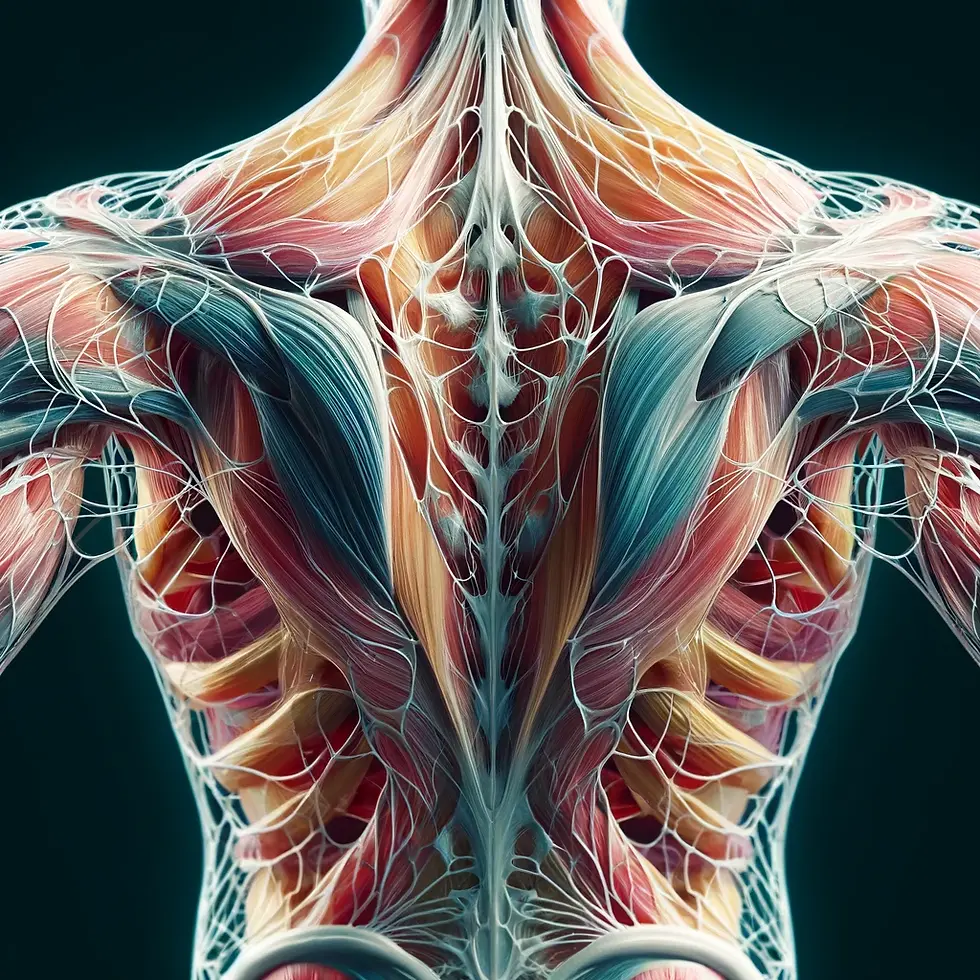Unlocking the Myofascia: How Yoga Supports Physical, Emotional, and Mental Well-being
- Radha Sharma
- Feb 6
- 4 min read
When we step onto the yoga mat, we often focus on stretching, strengthening, and finding moments of stillness. But beneath our muscles and bones lies an intricate web that plays a crucial role in our movement, posture, and even our emotional health—the myofascia. Understanding this system can transform your yoga practice, deepening its benefits beyond the physical.
What is the Myofascia?

The myofascia is a connective tissue network that surrounds and interweaves through muscles, bones, and organs. It provides structure, support, and communication throughout the body. This tissue is composed primarily of collagen and is meant to be supple and fluid, adapting to movement and stress.
However, due to poor posture, repetitive movements, stress, or trauma, the myofascia can become restricted, tight, or dehydrated. These restrictions can lead to discomfort, reduced mobility, and even chronic pain (Schleip, 2012). Moreover, because the fascia is rich in nerve endings and mechanoreceptors, restrictions in this tissue can impact our nervous system and overall well-being.
How Yoga Supports Myofascial Health
Yoga is an excellent way to promote myofascial health. Through mindful movement, breathwork, and relaxation, we can release tension and restore the elasticity of this tissue. As a Vinyasa yoga practitioner, you already have an excellent tool for keeping the myofascia fluid and healthy. Here’s how Vinyasa and other forms of yoga, including restorative practices, can help:

1. Dynamic Movements and Flow in Vinyasa Yoga
Vinyasa yoga’s continuous movement between poses encourages fluidity within the fascia. Since the fascia responds well to varied movement, transitioning dynamically between poses helps to maintain hydration and elasticity. The combination of deep, conscious breathing with movement also stimulates the nervous system, reducing stress and tension stored within the myofascia.
In sequences such as Sun Salutations, the body moves through multiple planes of motion, preventing fascial adhesions and increasing mobility. Additionally, the diversity of asanas—ranging from heart openers to hip openers—ensures that all parts of the fascial network receive attention.
2. Gentle, Sustained Stretching for Deeper Release

While Vinyasa Yoga helps with movement and hydration, holding stretches for longer periods is crucial for deep fascial release. Incorporating Yin-style elements or adding longer-held poses in your Vinyasa practice—such as a deep lunge in Anjaneyasana (Low Lunge) or a supported forward fold—allows for the remodeling and rehydration of the fascia (Findley & Schleip, 2007).

3. Breath and Relaxation Techniques
The autonomic nervous system plays a key role in fascia health. Chronic stress can lead to a contracted, rigid fascia. Practices like deep diaphragmatic breathing and mindful transitions in Vinyasa sequences activate the parasympathetic nervous system, encouraging relaxation and reducing tension in the fascia (Bordoni & Zanier, 2013).
Additionally, incorporating restorative poses at the end of a Vinyasa practice—such as Savasana, Supta Baddha Konasana (Reclining Bound Angle Pose) or Viparita Karani (Legs-Up-The-Wall Pose)—gives the fascia time to absorb the benefits of movement and enter a deep state of relaxation.
4. The Benefits of Restorative Yoga for Myofascial Release
While Vinyasa yoga emphasizes fluid movement, restorative yoga complements it by providing passive release. In restorative postures, where the body is fully supported by props, the nervous system shifts into a healing state, allowing the fascia to soften naturally. These longer-held, supported poses enable deep relaxation of both the muscles and the fascia, releasing accumulated tension and stress.
Restorative yoga can be particularly beneficial for those experiencing chronic pain, stress, or tension-based discomfort. Pairing Vinyasa yoga with occasional restorative sessions can create a well-rounded approach to myofascial health.
The Mind-Body Connection: Emotional and Mental Benefits
Beyond physical tension, the fascia holds emotional and energetic imprints. Have you ever noticed a deep emotional response during a hip-opening pose? That’s because fascia stores unresolved tension, particularly in areas like the hips and shoulders.
1. Releasing Stored Emotions
Fascial restrictions can correlate with emotional holding patterns. Trauma and stress may manifest as tightness in specific areas. Slow, mindful yoga allows us to safely access and release these stored emotions, creating space for healing (Van der Kolk, 2014).
2. Improved Mental Clarity and Reduced Anxiety

Since the fascia is deeply connected to the nervous system, working with it through yoga can promote mental clarity and reduce stress. As tension dissolves, we often experience a greater sense of emotional balance and resilience.
3. Increased Body Awareness
By tuning into fascial sensations, we develop deeper proprioception—our body’s sense of positioning in space. This heightened awareness fosters a stronger mind-body connection, helping us move with intention and ease in daily life.
Integrating Myofascial Awareness into Your Yoga Practice
Incorporate fluid Vinyasa sequences to keep the fascia hydrated and elastic.
Hold deeper stretches within your practice to target myofascial adhesions.
Practice breathwork and mindfulness to reduce stress-induced fascia rigidity.
Use restorative yoga poses to complement Vinyasa and promote deep fascial healing.
Listen to your body—if an area feels resistant, approach it with patience and care.
By incorporating these practices, we can support not only our physical health but also our emotional and mental well-being. The more we nurture our fascia, the more we unlock a sense of freedom and ease—both on and off the mat.
References
Bordoni, B., & Zanier, E. (2013). Understanding Fibroblasts in Order to Comprehend the Osteopathic Treatment of the Fascial System. Evidence-Based Complementary and Alternative Medicine, 2013, 1–12.
Findley, T. W., & Schleip, R. (2007). Fascia Research: Basic Science and Implications for Conventional and Complementary Health Care. Journal of Bodywork and Movement Therapies, 11(2), 123–127.
Schleip, R. (2012). Fascial Plasticity – A New Neurobiological Explanation. Journal of Bodywork and Movement Therapies, 16(1), 105–116.
Van der Kolk, B. (2014). The Body Keeps the Score: Brain, Mind, and Body in the Healing of Trauma. Penguin Books.
Wilke, J., et al. (2018). What is Evidence-Based About Myofascial Chains? A Systematic Review. Archives of Physical Medicine and Rehabilitation, 99(6), 1231–1243.




Comments